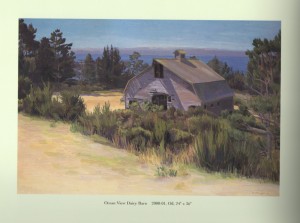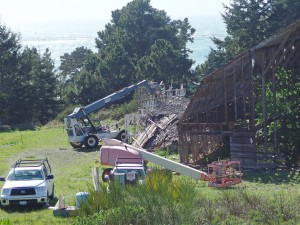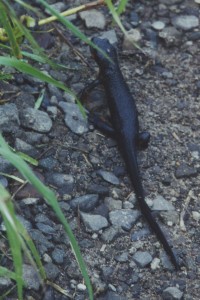Archive for March, 2014
End of an Era for Surfwood Barn
Our local landmark is being demolished. We’ve known it as the Surfwood Barn for the fourteen years we’ve lived here in the Mendocino Coast. It was originally part of the Joy Ranch, and then the Ocean View Dairy, which supplied milk to Mendocino from 1914 to 1939. Since then it has quietly decayed, and has been a favorite subject of plein air painters for decades. This 2001 painting by artist Kevin Milligan is from his book Mendocino: A Painted Pictorial.
The barn now sits on one of the parcels of the Surfwood IV development. We pass it daily on our walks around the neighborhood. We knew that the building, which has been held together for years by aircraft cable, was in a dangerous state, and the current owners of the property had received a demolition permit.
But the arrival of heavy equipment still came as a shock and a sadness.
Encounters with Newts
Now that our rains have finally started, the newts have come out of hiding. Last week I spent a couple of days at Green Gulch Farm, a Zen Buddhist retreat center and organic vegetable farm near San Francisco. California Newts were all over the paths. Their brown skin smooth, their underbellies a brilliant golden yellow, they were marching to the streams where they breed.
This morning we had to step around another California Newt on a path at the Mendocino Coast Botanical Gardens, a little one in its rough-skinned terrestrial phase. It was reluctant to move, since it was busy consuming a large earthworm; the last half-inch of the worm still hung from its mouth.
These encounters reminded me of visiting Montgomery Woods some years ago, when their close relatives the Red-bellied Newts were everywhere. I became fascinated with the story of their breeding migrations and wrote this poem, which was published in my 2007 chapbook, Quickening.
Red-Bellied Newt (Taricha rivularis)
What stirs, with the rain, that urge to return?
Some years she ignores the tingle in her nose,
the scent of that particular section of stream
where under a stone she hatched into a nymph,
then played for a year in the rippling water
before crawling transformed up the bank.
Summers she hides. Home is a secret hollow
under gnarled redwood roots in the ancient grove.
Some winters too. But once in a while, when the rains begin,
she emerges to make the journey to her breeding place.
Purposeful, she crawls, the red of her feet and belly
bright against the redwood duff,
navigating by smell to the rocky stream a mile away,
not home exactly, but the place she came from,
that pulls her back as it pulled her mother back.
Here she will mate, immersed in the water that gave her life,
deposit the fruits of her procreation under a stone,
then wander off to find good forage for the summer.
For thousands of years, as the giants grew overhead,
her kind have made this journey, secure in their faith
that the stream will still flow clear and fast over rocks.
They raise a question: what pulls us humans,
and to what deep places, and what is it we deposit,
like fertile newt eggs on the undersides of stones?


